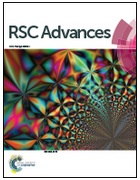In this study Fe-doped TiO2 (0.35 to 3.50 wt% Fe) nanotubes (NTs) were prepared as the potential photosensitizer for near-visible light driven photodynamic therapy (PDT) against cervical cancer cells (HeLa). Characterization of the prepared nanotubes by X-ray diffraction (XRD), Raman spectroscopy and X-ray photoelectron spectroscopy (XPS) confirmed the successful incorporation of Fe3+ as a dopant into the TiO2 matrix, which was mainly composed of an anatase phase, while elemental mapping using energy dispersive X-ray spectroscopy (EDX) showed homogenous distribution of the dopant ions in TiO2 for both low and high doping levels. UV-Vis studies showed that Fe doping in TiO2 increases the light absorption within the visible range, particularly in the case of 0.70 and 1.40 wt% Fe–TiO2 and provides additional energy levels within the band gap, which promotes the photo-excited charge transport towards the conduction band. Photo-cytotoxic activity of the prepared Fe-doped TiO2 NTs was investigated in vitro against cervical cancer cells (HeLa) and compared with human normal fibroblasts (GM07492). Fe-doped TiO2 NTs exhibited no or lower dark cytotoxicity than un-doped TiO2 NTs, which confirms their superior biocompatibility. Under the near-visible light irradiation (∼405 nm) Fe-doped TiO2 NTs showed higher photo-cytotoxic efficiency than un-doped TiO2 NTs, which was found to be dependent on the NTs concentration, but not on the incubation time of cells after near-visible light irradiation. The highest activity was observed for 0.70 and 1.40 wt% Fe–TiO2 NTs. Fluorescent labeling of treated HeLa cells showed distinct morphological changes, particularly in the perimitochondrial area suggesting a mitochondria-involved apoptosis of cells, but also the nuclei and cytoskeleton were subject to Fe–TiO2 NTs induced photo-damage. Apoptosis of PDT treated HeLa cells was also confirmed using ethidium homodimer (EthD-1).
